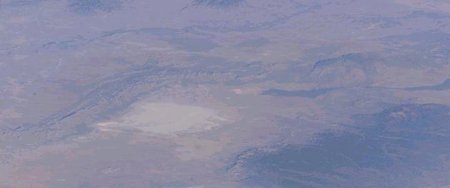Jornada del Muerto Desert
|
|
The Jornada del Muerto ("journey of the deadman" in Spanish) was the name given by the Spanish conquistadors to the 1660s route northward from New Spain, or Mexico. This route northward, taken by the earliest European settlers, by horseback, oxen and foot, led to what is now the State of New Mexico, in the U.S.. It covers harsh territory, called to this day, in Mexico, El Fronterizo, 'The Frontier'. The name doubtless was applied to the valley surrounding a major river, called Rio Bravo, now called the Rio Grande, in the U.S.

After this journey, these earliest Spanish settlers encountered, not the Seven Cities of Cibola, but the humbler walled villages of the Pueblo dwellers, who had a well-developed agriculture and a peaceable tradition, and enslaved them. They stood the situation for twenty years, and then arose in revolt. According to the lore of this area, even the sacrifice of a maiden failed to improve the situation. It is said that they passed along a knotted rope to inform the other pueblos to rise up. The conquistadors were forced to retreat two hundred miles southward, along with a faithful few from Isleta Pueblo, to the south of the Rio Grande at El Paso del Norte, 'the Pass to the North', which is now the site of El Paso, Texas, U.S.A., and Ciudad Juárez, Chihuahua, Mexico. The town of Ysleta, in El Paso County, even now houses the Tiwa descendants of those Pueblo dwellers.
After regrouping, the Conquistadors returned to the North for good. Today the term 'Jornada del Muerto' is applied to the adjacent valley to the east of the Rio Grande valley, north of the Organ Mountains and the Sacramento Mountains of New Mexico, which is much drier. These mountains are adjacent to a large lava flow (the Malpais), near the site of the first atomic bomb detonation, code-named Trinity site, which is open to the public only twice a year. Travellers on the road between Las Cruces and the towns of Alamogordo and Tularosa, will glimpse the more accessible dunes of the White Sands National Monument, the occasional Stealth aircraft rising from Holloman Air Force Base, and the White Sands Missile Range. Now, the Rio Grande valley grows pecans, the White Sands Missile Range tests anti-ballistic missile systems, and the Native Americans run ski resorts.de:Jornada del Muerto
